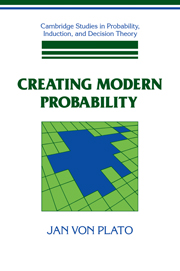Book contents
- Frontmatter
- Contents
- Preface
- 1 Introduction
- 2 Pathways to modern probability
- 3 Probability in statistical physics
- 4 Quantum mechanical probability and indeterminism
- 5 Classical embeddings of probability and chance
- 6 Von Mises' frequentist probabilities
- 7 Kolmogorov's measure theoretic probabilities
- 8 De Finetti's subjective probabilities
- Supplement: Nicole Oresme and the ergodicity of rotations
- Bibliography
- Index of Names
- Index of Subjects
3 - Probability in statistical physics
Published online by Cambridge University Press: 05 June 2012
- Frontmatter
- Contents
- Preface
- 1 Introduction
- 2 Pathways to modern probability
- 3 Probability in statistical physics
- 4 Quantum mechanical probability and indeterminism
- 5 Classical embeddings of probability and chance
- 6 Von Mises' frequentist probabilities
- 7 Kolmogorov's measure theoretic probabilities
- 8 De Finetti's subjective probabilities
- Supplement: Nicole Oresme and the ergodicity of rotations
- Bibliography
- Index of Names
- Index of Subjects
Summary
CONCEPTS OF PROBABILITY IN CLASSICAL STATISTICAL PHYSICS
The definition of probability
Around the middle of the last century, the mechanical theory of heat had won ground over caloric and other competing theories. The idea that heat consists of the motion of molecules was not new; it can be found already in Daniel Bernoulli in 1738. But in the 1840s the principle of conservation of energy was finally established. It became the foundation of the science of thermodynamics and was referred to as its first law. The second law of thermodynamics is the famous entropy principle, a name given by Rudolph Clausius. In its strict form, it professes the necessary equalization of all temperature differences: The gloomy finale of the world stage is a heat death of the universe. Such a thermodynamical prediction loses its edge in statistical physics, which says that temperature equalization is not necessary but only extremely probable. In order to illustrate the statistical character of the second law, Maxwell imagined in the late 1860s a small demon, monitoring molecular motions and thereby being able to work against temperature equalization. These thermodynamic and probabilistic issues within physics also had a more general cultural significance. The prospect of heat death connected with a pessimistic sentiment seeing degeneration as the essential direction of things. Its counterpoint was the emergence of Darwin's evolutionary theory with which some creators of the kinetic theory, Boltzmann especially, felt close sympathies.
- Type
- Chapter
- Information
- Creating Modern ProbabilityIts Mathematics, Physics and Philosophy in Historical Perspective, pp. 71 - 141Publisher: Cambridge University PressPrint publication year: 1994

